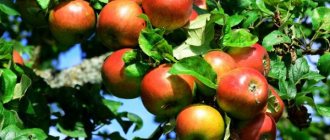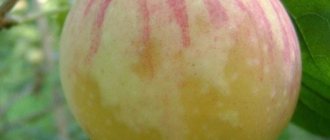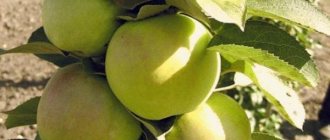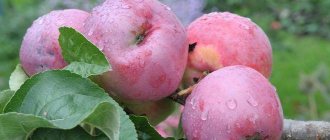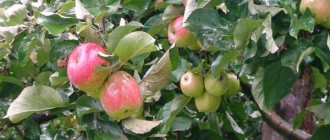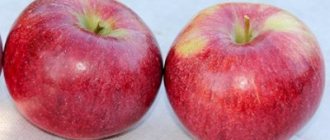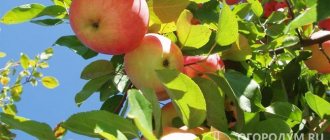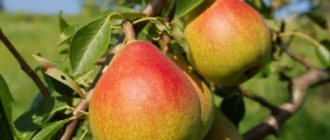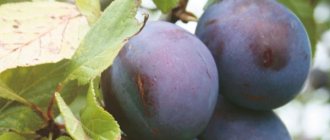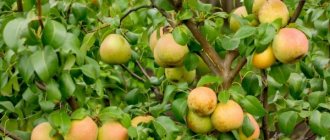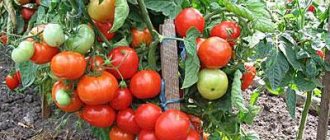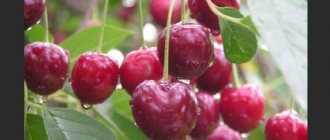Gardening » Apple tree
0
597
Article rating
Kira Stoletova
The Bolotovskoe apple tree has been pleasing gardeners for more than 40 years. Everyone loved them for their rich harvests, high immunity to diseases and parasites, distinctive sweetness and absolute ease of care.
Varietal description of the Bolotovskoye apple tree
The variety can be attributed to early winter. It was bred by Russian breeders in 1977, during the synthesis of Skryzhapel and No. 1984. It successfully passed a number of tests and was entered into the state register.
Apple tree Bolotovskoe: description of the variety and characteristics
Apple tree Bolotovskoye: photo of variety
Like any apple tree, the Bolotovskoye apple tree variety has both advantages and disadvantages. The advantages include the taste of the fruit, high immunity to scab, and abundant fruiting. Negative qualities include a short shelf life of fruits, as well as shedding of apples when fully ripe.
The Bolotovskoye apple tree has a medium size and a sparse crown in the shape of a ball. The bark of the tree is quite smooth, has a brown tint and slight pubescence on the branches.
The leaf blades are quite large, have the shape of an elongated oval and a rich dark green color. The surface of the leaves is glossy, slightly wrinkled. The edges of the leaf plate are jagged. Each leaf is attached with a strong petiole. The leaves have a pronounced vein pattern.
The fruits of the Bolotovskoye apple tree are small, each weighing about 150 g. The shape of the fruit is round, slightly flattened. Compared to other varieties of apples, there is no characteristic shine or bloom. Ripe fruits have a yellow tint and a small bright blush that can cover the entire fruit. The apple pulp tastes quite dense, has a light green tint and a large amount of juice. Experts rate the taste of the fruit at 4.3 points, exactly the same as the appearance.
The fruits contain a large amount of useful substances, which include sugars, acids, pectin, and P-active substances. The tree has a fairly high resistance to frost, but temperatures lower than minus 36 degrees will have a negative effect on the apple tree.
If you want the tree to begin bearing fruit as early as possible, you should not apply large amounts of nitrogen preparations. To ensure that the plant has enough iron, you can bury various old nails and bolts under the tree.
As already described above, the tree is highly resistant to scab.
In order for the plant to bear fruit, it is necessary to plant on the plot such varieties as Antonovka, Pepin saffron and other apple trees that bloom in the same period as the Bolotovskoye apple tree.
Pollination should occur in cool, dry weather. In addition, it is prohibited to use insecticides during apple tree flowering, since insects will not pollinate the plants. The tree has a fairly long lifespan, about 50 years.
Description
The variety produces large fruits, the weight of which ranges from 150 to 180 grams. They have a round, flattened shape and noticeable ribs. The skin is first yellow-green, then it turns yellow, and the surface is covered with a red blush in the form of stripes and spots. It feels oily to the touch, and there is no waxy coating.
Eukomis pineapple lily Planting and care in open ground Growing from seeds Reproduction Photo
Dense pulp of an unusual green hue. The juice content in it is high, and the taste is good, sweet and sour. The purpose is universal; preserves, jams, compotes, and dried fruits are made from the fruits.
The yield is high, almost twice as high as that of Antonovka, growing under similar conditions. In experimental plantings it was 130 c/ha. Apples are harvested at technical ripeness, in early September. According to reviews, if harvesting is delayed, the fruits may crumble and become unsuitable for long-term storage.
To store them for the winter, undamaged fruits are selected, carefully placed in layers of disinfected containers and covered with soft material. Refrigerating chambers with a controlled gas environment serve as storage facilities. The humidity in them is maintained constant at 85%. Stored in this way, apples can last until mid-February, maintaining their taste and healthiness.
Trees of significant, above average growth vigor. The trunk is covered with smooth greenish bark. Sparse branches form a rounded crown. The shoots are brown, faceted. The leaves are large, embossed, elongated, with curled tips. They are attached with powerful reddish, pubescent petioles. The flowers are large and white.
Apple tree Bolotovskoye: reviews about the variety
Apple tree Bolotovskoye: photo of variety
Considering the reviews of gardeners who have already grown this crop on their plots, it is worth noting that the Bolotovskoye apple tree really does not get scab, moreover, the crown has a compact size and a fairly good taste of the fruit. Others note the large amount of harvest and their long shelf life.
Some gardeners use the fruits to prepare preparations. They make especially good juice.
Pest and disease control methods
The Bolotovskoye variety has the highest resistance to scab and good immunity to fungal diseases.
Did you know? The smallest apples are produced by the “Chinese Golden Early” apple tree, obtained by crossing the “Kitayka” and “White Naliv” varieties. The weight of the fruits averages 40 g, and their size is only 5-6 cm in diameter.
However, unfavorable climate conditions and violation of basic rules of agricultural technology can provoke the development of other, no less dangerous ailments:
- powdery mildew;
- fruit rot;
- cytosporosis;
- bacterial burn;
- black cancer.
Simple preventive measures will help fight diseases:
- regular loosening of the soil and destruction of weeds;
- clearing the soil of vegetation;
- whitewashing the trunk and skeletal branches;
- systematic treatment of wood with Bordeaux mixture and copper sulfate solution;
- spraying the plant with fungicidal and insecticidal preparations.
The fungicides “Horus” and “Skor” have good effectiveness against diseases. In the control and prevention of pests, insecticides “Aktara”, “Inta-Vir” or “Karbofos” are recommended. It is recommended to carry out disinfection twice a season - before the flowering phase of the plant and after the formation of ovaries. The hybrid has excellent winter hardiness and is able to tolerate low temperatures, down to –38 C. When growing a tree in a warm climate, there is no need to take special measures to cover the plant. It is enough to wrap the tree trunk with natural, breathable material or special insulation.
In winter, it is recommended to make a snowdrift around the trunk, up to 1 m high.
Apple tree Bolotovskoe: planting varieties
Apple tree Bolotovskoye: photo of variety
The optimal time for planting the Bolotovskoye apple tree variety will be spring, after the soil has already warmed up sufficiently. You can plant a tree in the fall, but you need to leave enough time before the first frost. When choosing the spring period for planting, the guideline will be April and May.
All seedlings that have a closed root system can be planted even in summer. However, it is necessary to create a shadow so that the scorching rays of the sun do not damage the tree.
It is necessary to prepare a planting hole in advance, which will be quite spacious - more than half a meter in all directions. If you have other plantings on your site, you must leave a distance of at least 3 meters between them. At the base of the hole, a support peg is immediately driven in, to which the seedling will be tied. When planting a tree, you should ensure that the grafting level is at least 5 cm above ground level.
Having placed the seedling on a mound, you should carefully straighten the root system, and then fill the hole with the remaining soil. After planting, the tree is tied to a support and watered thoroughly.
Agricultural technology for planting young seedlings
The agricultural technology for planting young seedlings of the described hybrid is practically no different from the process of planting other crop varieties. The main thing during the event is to choose the most suitable place for the apple tree and choose high-quality, healthy planting material.
Selection of location and soil
When choosing a place to plant a seedling, experts recommend giving preference to sunny, spacious areas, reliably protected from drafts and cold winds.
The apple tree has a strong, well-developed root system, so the groundwater level must be at least 2-2.5 m deep, otherwise the roots of the plant will suffer from excess moisture.
The hybrid "Bolotovskoe" prefers to grow on loose, light and nutritious soils. The best option would be black soil or loam.
When planting in clay soil, it is necessary to “ennoble” it with peat and sand; when planting in sandy soil, add humus or manure.
Landing technique
Planting work is allowed to be carried out in the spring - after the soil has completely thawed, or in the fall - from the second ten days of September until the onset of the first frost. For planting, choose a healthy one-year-old seedling that has strong, undamaged root shoots and a strong, elastic bark.
Description of the Lada pear variety - frost resistance, yield, gardener reviews, photos
It is not recommended to use planting material two years old, since when it is dug out of the soil in the nursery, the roots are injured, which negatively affects the survival rate of the plant.
Before carrying out planting work, it is necessary to carefully prepare the area: clear of remaining vegetation, dig to the depth of a spade bayonet.
Next, the landing is carried out according to the following algorithm:
- dig a hole measuring 70x70 cm;
- to feed the seedling, a mixture of a small amount of garden soil, compost, humus, peat and ash, with a total volume of 2-3 buckets, is poured into the prepared hole;
- a small mound is made from the soil mixture, into which a wooden peg is inserted, which serves as a support for the seedling;
- a seedling is placed on an earthen hill, the roots are carefully leveled;
- the plant is covered with soil so that the place of the trunk remains 5-8 cm above the surface. The soil around the trunk circle is compacted a little by hand;
- The seedling is tied to a peg and the ground is watered abundantly.
Apple tree Bolotovskoye: variety care
Fruits of the Bolotovskoye apple tree variety: photo
The plant is unpretentious and care is reduced to ordinary manipulations, as with other fruit trees. In order for the harvest to be good, it is necessary to carry out timely watering, apply fertilizers, and carry out preventive measures against insects - pests and diseases. Despite the fact that the tree has a high immunity to scab, there is a risk of infection with other diseases, such as powdery mildew, bacterial cancer and others.
Like any tree, the Bolotovskoe apple tree needs timely formation.
Therefore, it is necessary to perform annual pruning, where old, dry, diseased branches are removed. Also branches growing inside the crown and down, and areas that have been affected by diseases or insect pests.
Basic care requirements
The Bolotovskoye variety belongs to the category of plants that do not require too careful and painstaking care.
Find out how to get rid of rotting apples.
To obtain a high-quality, abundant harvest, it is enough to adhere to the main rules of agricultural technology:
- Watering. Young seedlings, 3-5 years old, need regular, abundant moisture, which is recommended once every two weeks under normal climatic conditions, and once a week during drought. It is necessary to pour at least 6-7 buckets of water onto one tree. Adult plants will need about 10-12 buckets for complete moisture. It is especially important to provide the crop with sufficient moisture before bud break, 2-3 weeks after flowering and after harvesting. After irrigation activities, it is recommended to loosen the soil well.
- Feeding. In the first year of growth, the plant does not need fertilizing, since a certain amount of nutritional components was added to the planting hole. It is recommended to fertilize the apple tree starting from the second year. The first fertilizing should be carried out in early spring, using a composition of urea, saltpeter and humus. The second portion of fertilizer should be applied during the flowering period of the hybrid. To do this, use a mixture of 10 liters of water, 100 g of superphosphate, 300 g of urea, 1.5 liters of liquid bird droppings and 0.5 buckets of manure. In the summer, you can feed the plant using the foliar method, using purchased phosphorus or potassium preparations. In the fall, after harvesting the fruits, the crop needs to be fed with liquid phosphorus-potassium preparations.
- Trimming. Since the hybrid does not have a thickened crown, there is no need to trim the shoots annually. A young plant needs to undergo formative pruning, shortening the shoots by 1/3 of their length. It is recommended to do the cutting of shoots in early spring, before the onset of the sap flow phase. We also must not forget about sanitary pruning, during which dry, damaged, broken and weak branches are removed. All cut areas must be treated with garden pitch or crushed charcoal.
- Loosening and weeding. One of the main conditions for caring for an apple tree is loosening the soil and weeding. It is recommended to remove parasitic plants regularly, focusing on the condition of the soil. Weeds should not be allowed to grow strongly, as they inhibit the development of the root system of the crop. It is necessary to systematically loosen the soil, which allows you to enrich the soil with oxygen and saturate it with nutrients, thus activating the growth of the crop.
Fruiting and productivity
This variety is early-bearing, since the first fruits can be harvested 4 years after the seedling is planted. Trees that were grown on a dwarf rootstock begin to bear fruit especially early. So, after 2 years they already begin to bloom. The columnar apple tree Bolotovskoye begins to bear fruit a year after planting.
Since the tree is an early winter tree, it can be harvested in early autumn, namely in September. Fruits collected in September are well suited for preparing preparations and canned food. After the apples have been left for at least another month, their taste properties improve and the fruits can be consumed fresh. If you are a little late in harvesting, the apples may fall off.
By observing the correct storage conditions for the crop, apples retain their appearance well until the end of winter. In this case, it is necessary to ensure that the air temperature in the room is not lower than 2 and not more than 8 degrees. The humidity level should be between 60 and 80%. In addition, only those fruits that are not damaged will last well and for a long time.
Speaking about productivity, it is worth noting that a hectare of plantings can yield 130 centners of apples. This is a very large indicator in comparison with other well-known varieties. In addition, there are so many apples ripening that the branches can break off under their weight.
When growing apple trees, you can use various rootstocks for a given variety. However, they differ from each other.
Medium-sized rootstocks provide the new plant with rapid growth vigor. In the future, such a tree will reach 6 meters in height.
Semi-dwarf rootstocks do not produce high vigor, and the maximum tree height will be 5 meters.
Trees grown on a dwarf rootstock are compact and early fruiting. The height of such an apple tree will not exceed 3.5 meters.
Reviews
Lyubov Semyonovna T., Orlov. “I planted this apple tree 8 years ago. It was highly praised at the nursery as a new variety that was immune to scab. They didn’t lie - she never got sick. The tree itself is very neat and grows well. It produced apples in the fourth year after planting, and they were quite large. But for my taste they are a little sour, but my grandson likes them.” Sergey F. Kinel. The Bolotovskaya apple tree was bought on the advice of a neighbor and after looking at the description and photo on the Internet. A neighbor takes 20 buckets of harvest from her! She gave me an apple to try - tasty, juicy, just right for winter storage. Plus it is not affected by scab (it already tormented me at Melba). "Vlad. Krasnodar city. ‟This variety is apparently new, there are few reviews on it. I’m telling you: an ordinary apple tree. It grows normally, blooms like everyone else, after 3-4 years, does not require special care. The first harvest was 2 apples, now she is 10 years old and yields 15 buckets. One year I didn’t have time to collect them on time and they fell apart. I also don’t like the look of the fruits: they’re kind of dull, but at least they’re large. The taste is like taste, sweet and sour. My wife switches them to juice because they are juicy.
I’m pleased with the variety, but without wild delight.”
Growing regions
Apple tree Bolotovskoye: photo of variety
The Bolotovskoye apple tree variety was bred with a recommendation for cultivation in the Moscow region, and it is there that the tree shows all its positive properties. Winters for this region are not very severe and do not exceed 36 degrees below zero, which is a favorable condition for growing Bolotovskaya.
However, when the tree is still young, the seedling must be insulated before the winter period. For this purpose, special materials are used: spunbond or others. In this way, you will protect the plant not only from severe cold, but also from rodents.
In very cold years, the plant's fruit buds may be damaged. Therefore, if the apple tree is frozen, then in the spring it will be necessary to remove the affected tissues, as well as add nitrogen-containing preparations for the speedy restoration of damaged tissues.
Region of growth and distribution
The variety is adapted to cold winter conditions and is recognized as suitable for industrial cultivation in climatic conditions characteristic of the Central Black Earth region.
Tolerates frosts down to -38C. At -42C young shoots are damaged.
It is also suitable for growing in regions with a warmer climate, for example, in the southern regions of the Russian Federation and Ukraine.
The following varieties are also suitable for planting in this region: Golden Delicious, Malinovka, Starkrimson, Uslada and Quinti.
Features of harvesting and storage
Fruit ripening of the Bolotovskoye variety occurs in the first weeks of September. It is at this time that it is recommended to remove the fruits.
Important! Overripe fruits are prone to shedding, therefore, experts do not advise delaying fruit harvesting.
It should be noted that the hybrid is self-sterile, therefore, to obtain stable and decent yields, pollinating varieties must be planted near the tree.
The best donors for the described plant are:
- "Antonovka";
- "Pepin saffron";
- "Orlik".
Harvesting is carried out in dry, warm weather. Picked apples are stored in wooden, cardboard or plastic boxes. It is recommended to place fruits in several layers, each layered with straw or hay. The optimal conditions for storing apples are:
- refrigerator or dry, cool, well-ventilated place;
- temperature indicators - 0...+2 °C;
- relative humidity: 80-90%.
Under such conditions, the harvest can last until March, without changing its marketability and taste.
The hybrid "Bolotovskoye" is considered one of the best dessert varieties of apple trees, which can delight you with strong immunity, high winter hardiness, excellent keeping quality and transportability of fruits, and ease of care.
By following simple rules of agricultural technology, even a novice gardener can obtain abundant, annual harvests of tasty and juicy fruits.
